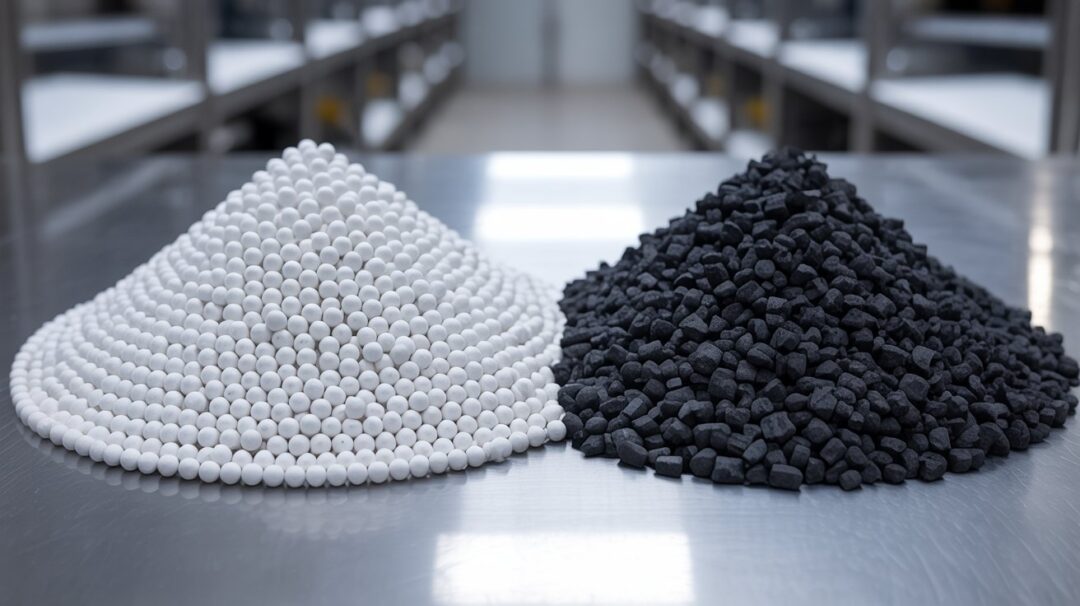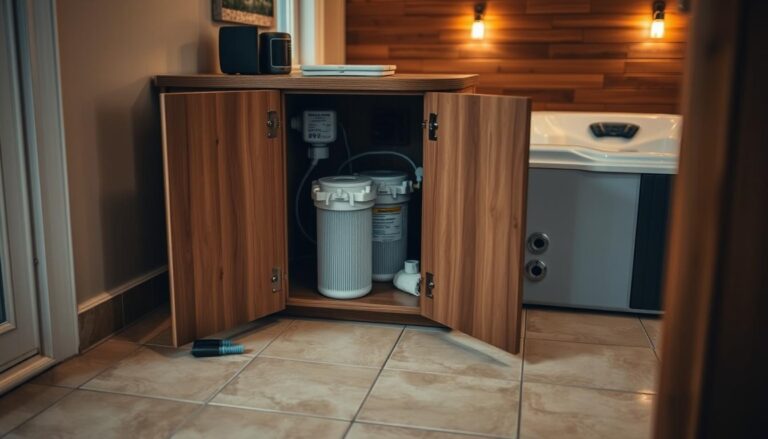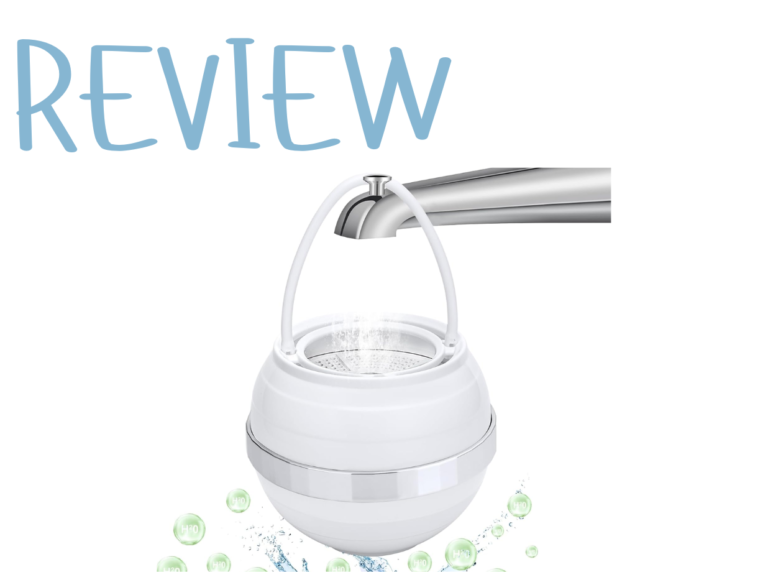Activated Alumina vs Activated Carbon: Key Differences
When it comes to filtration media, two popular options are often considered: activated alumina and activated carbon. But what sets them apart?
Understanding the differences between these two materials is crucial for selecting the right one for specific applications, whether it’s for water purification, air cleaning, or industrial processes.
The choice between activated alumina and activated carbon depends on various factors, including the type of contaminants to be removed and the specific requirements of the application.
Key Takeaways
- Activated alumina and activated carbon serve different purposes in filtration.
- The choice between them depends on the specific application and contaminants.
- Understanding their differences is key to selecting the right material.
- Both materials have unique properties that make them suitable for various uses.
- Proper selection ensures effective filtration and purification.
What Are Activated Alumina and Activated Carbon?
The comparison between activated alumina and activated carbon begins with understanding what they are. Both materials are widely used in various applications, including water treatment, air purification, and industrial processes, due to their adsorption properties.
Definition and Basic Composition
Activated alumina is a porous form of aluminum oxide (Al2O3), derived from aluminum hydroxide through a dehydration process. It is known for its high surface area and adsorption capacity. On the other hand, activated carbon is a highly porous form of carbon, typically produced from organic materials such as coconut shells, wood, or coal. Its high porosity and large surface area make it an effective adsorbent for a wide range of contaminants.
Manufacturing Processes
The manufacturing process for activated alumina involves the calcination of aluminum hydroxide, followed by activation through heat treatment. This process enhances its porosity and adsorption capacity. For activated carbon, the production involves carbonization of the raw material, followed by activation, typically through steam or chemical means. The activation process significantly increases the material’s surface area and porosity, making it highly effective for adsorption.
Understanding these manufacturing processes is crucial for appreciating the differences in properties and applications between activated alumina and activated carbon.
Physical Properties Comparison
The physical attributes of activated alumina and activated carbon, such as surface area and density, play a vital role in determining their suitability for specific tasks. Understanding these properties is essential for selecting the most appropriate material for various applications.
Surface Area and Porosity
Both activated alumina and activated carbon are known for their high surface areas and porosity, which are critical for their adsorption capacities. Activated carbon typically has a higher surface area, often exceeding 1000 m2/g, while activated alumina’s surface area can range from 200 to 400 m2/g.
Particle Size and Shape
The particle size and shape of these materials can significantly affect their performance in different systems. Activated alumina is often available in spherical shapes, which can improve flow characteristics in certain applications, whereas activated carbon can be found in various forms, including granular, powdered, or pelletized.
Density and Hardness
Density and hardness are other critical physical properties. Activated alumina is generally denser and harder than activated carbon, making it more resistant to attrition and suitable for applications where mechanical strength is important.
| Property | Activated Alumina | Activated Carbon |
|---|---|---|
| Surface Area | 200-400 m2/g | >1000 m2/g |
| Particle Shape | Spherical | Granular, Powdered, Pelletized |
| Density | Higher | Lower |
| Hardness | Harder | Less Hard |
Chemical Properties and Composition
Understanding the chemical properties of activated alumina and activated carbon is crucial for determining their effectiveness in various applications. The chemical structure of these materials significantly influences their adsorption mechanisms and overall performance.
Chemical Structure of Activated Alumina
Activated alumina is composed of aluminum oxide (Al2O3), which gives it a high surface area and reactivity. Its chemical structure allows it to adsorb a wide range of contaminants, including fluoride, arsenic, and selenium. The aluminum oxide composition is key to its adsorption capabilities, making it an effective medium for water treatment and industrial applications.
Chemical Structure of Activated Carbon
Activated carbon, on the other hand, is primarily made up of carbon, with a highly porous structure that enables it to adsorb a broad spectrum of contaminants. The activation process enhances its surface area, making it highly effective for removing chlorine, volatile organic compounds (VOCs), and other impurities from water and air. The chemical structure of activated carbon is characterized by its high degree of porosity and reactivity.
In summary, the chemical properties and composition of activated alumina and activated carbon are fundamental to their adsorption mechanisms and overall effectiveness. Understanding these properties is essential for selecting the most appropriate material for specific applications.
Adsorption Mechanisms and Capacity
Understanding the adsorption mechanisms of activated alumina and activated carbon is crucial for determining their effectiveness in various applications.
How Activated Alumina Adsorbs Contaminants
Activated alumina is known for its ability to remove contaminants such as fluoride and arsenic from water through a process of chemical adsorption. This occurs due to its high surface area and the presence of aluminum oxide, which provides active sites for adsorption.
Polar vs. Non-Polar Adsorption
The surface of activated alumina is polar, making it more effective at adsorbing polar contaminants. This characteristic is particularly useful in applications where the removal of specific polar contaminants is required.
Capacity Limitations
While activated alumina is effective, its adsorption capacity can be limited by factors such as pH and the presence of competing ions. Regular regeneration can help maintain its effectiveness.
How Activated Carbon Adsorbs Contaminants
Activated carbon, on the other hand, is renowned for its ability to adsorb a wide range of organic compounds and chlorine. Its effectiveness is largely due to its high surface area and porous structure, which facilitate physical adsorption.
Physical vs. Chemical Adsorption
Activated carbon primarily operates through physical adsorption, where contaminants are attracted to its surface through van der Waals forces. However, some forms of activated carbon can also exhibit chemical adsorption properties.
Capacity Limitations
The adsorption capacity of activated carbon can be affected by its pore size distribution and the presence of impurities. Its effectiveness can also diminish over time, requiring replacement.
| Adsorbent | Primary Adsorption Mechanism | Typical Contaminants Removed |
|---|---|---|
| Activated Alumina | Chemical Adsorption | Fluoride, Arsenic |
| Activated Carbon | Physical Adsorption | Organic Compounds, Chlorine |
Activated Alumina vs Activated Carbon: Direct Comparison
Both activated alumina and activated carbon are popular media for adsorption, but their performance varies significantly across different contaminants and operating conditions. Understanding these differences is essential for selecting the most appropriate material for specific applications.
Adsorption Efficiency for Different Contaminants
Activated alumina and activated carbon exhibit different adsorption efficiencies for various contaminants. Activated alumina is particularly effective in removing fluoride, arsenic, and certain heavy metals from water, making it a preferred choice for specific industrial and drinking water treatment applications. On the other hand, activated carbon is renowned for its ability to adsorb a wide range of organic compounds, chlorine, and volatile organic compounds (VOCs), which makes it ideal for water and air purification systems.
The difference in adsorption efficiency can be attributed to the unique chemical and physical properties of each material. Activated alumina’s high affinity for certain inorganic compounds stems from its chemical structure, while activated carbon’s effectiveness against organic compounds is largely due to its high surface area and porosity.
Regeneration Capabilities and Lifespan
Another critical aspect to consider when comparing activated alumina and activated carbon is their regeneration capabilities and lifespan. Activated alumina can be regenerated multiple times, which extends its operational lifespan and makes it a cost-effective option for certain applications. In contrast, activated carbon’s regeneration is more complex and less frequently performed, although it can still be reused under specific conditions.
The regeneration capabilities directly impact the overall cost-effectiveness of these materials. While activated alumina offers the advantage of multiple regenerations, activated carbon’s lower initial cost and wide applicability often offset its shorter lifespan and more limited regeneration potential.
Water Treatment Applications
In the realm of water treatment, activated alumina and activated carbon play distinct yet crucial roles. Both materials are utilized for their unique adsorption properties, making them essential components in water purification systems.
Activated Alumina in Water Purification
Activated alumina is particularly effective in removing contaminants such as fluoride and arsenic from water. Its high adsorption capacity makes it an ideal choice for communities affected by these pollutants.
Fluoride and Arsenic Removal
The use of activated alumina for fluoride and arsenic removal is well-documented. It operates effectively by attracting and holding these contaminants, thus providing safer drinking water.
pH Considerations
The efficiency of activated alumina in water treatment can be influenced by the pH level of the water. Optimal performance is typically achieved within specific pH ranges, making pH adjustment a crucial step in the treatment process.
Activated Carbon in Water Purification
Activated carbon, on the other hand, is renowned for its ability to remove organic contaminants, chlorine, and taste/odor-causing compounds from water. Its vast surface area and porous structure enable it to capture a wide range of chemical pollutants.
Organic Contaminant Removal
Activated carbon’s effectiveness in removing organic contaminants is attributed to its high surface area and the Van der Waals forces that attract and retain these molecules.
Chlorine and Taste/Odor Removal
Furthermore, activated carbon is highly effective in removing chlorine and compounds that cause unpleasant tastes and odors, significantly improving the overall quality and palatability of drinking water.
| Characteristics | Activated Alumina | Activated Carbon |
|---|---|---|
| Primary Use in Water Treatment | Fluoride and Arsenic Removal | Organic Contaminant, Chlorine, and Taste/Odor Removal |
| Adsorption Capacity | High for inorganic contaminants | High for organic contaminants and chlorine |
| pH Sensitivity | Sensitive, requires optimal pH range | Less sensitive to pH changes |
Filtration System Design Considerations
When it comes to designing filtration systems, understanding the differences between activated alumina and activated carbon is essential for optimal performance. The design of these systems depends on various factors, including the type of contaminants to be removed and the operational parameters of the system.
Activated Alumina Filtration Systems
Activated alumina filtration systems are particularly effective for removing fluoride, arsenic, and other inorganic contaminants from water. The design of these systems must consider the flow rate, bed depth, and contact time to ensure efficient adsorption. A typical configuration includes a fixed bed adsorber, where the water flows through the activated alumina media.
Activated Carbon Filtration Systems
Activated carbon filtration systems, on the other hand, are widely used for removing organic compounds, chlorine, and volatile organic compounds (VOCs). The design of these systems involves considerations such as carbon type, bed configuration, and regeneration capabilities. A comparison of the two media is presented in the following table:
| Characteristics | Activated Alumina | Activated Carbon |
|---|---|---|
| Primary Use | Removal of inorganic contaminants | Removal of organic compounds and VOCs |
| Adsorption Capacity | High for inorganic contaminants | High for organic compounds |
| Regeneration | Possible with caustic solution | Possible with thermal reactivation |
Air Purification and Gas Treatment
The quest for cleaner air has led to the widespread use of activated alumina and activated carbon in gas treatment. Both materials have unique properties that make them effective for different aspects of air purification.
Activated alumina is particularly useful for gas drying and purification. Its high surface area and chemical stability allow it to adsorb moisture and certain contaminants from gas streams effectively. As noted by industry experts, “Activated alumina’s ability to dry gases to a very low dew point makes it an essential component in many industrial gas processing applications.”
Activated Alumina for Gas Drying and Purification
Activated alumina is widely used for drying gases such as natural gas, air, and other industrial gases. Its effectiveness in removing moisture prevents corrosion and ensures the quality of the gas for industrial use. The material’s high adsorption capacity for water vapor makes it ideal for applications requiring very low dew points.

Activated Carbon for Odor and VOC Removal
On the other hand, activated carbon is renowned for its ability to remove odors and volatile organic compounds (VOCs) from air streams. The porous structure of activated carbon provides a large surface area for adsorption, making it highly effective at capturing a wide range of organic compounds. As highlighted in a study, “Activated carbon’s versatility in adsorbing various VOCs has made it a staple in air purification systems across different industries.”
The choice between activated alumina and activated carbon depends on the specific requirements of the air purification task. For applications where moisture removal is critical, activated alumina is the preferred choice. Conversely, for removing odors and VOCs, activated carbon is more effective.
Industrial Applications Beyond Filtration
The versatility of activated alumina and activated carbon extends into multiple industrial sectors, showcasing their adaptability and wide range of applications.
Catalysis and Chemical Processing
Both activated alumina and activated carbon are utilized as catalysts or catalyst supports in various chemical reactions. Activated alumina is often used in the petroleum industry for Claus process catalysis, where it helps in the conversion of hydrogen sulfide into sulfur. On the other hand, activated carbon is employed in the production of chemicals such as chlorine and caustic soda, where it acts as a catalyst or catalyst support.
| Application | Activated Alumina | Activated Carbon |
|---|---|---|
| Catalysis | Claus process catalysis | Catalyst in chemical production |
| Chemical Processing | Drying of gas streams | Recovery of solvents |
Medical and Pharmaceutical Uses
In the medical and pharmaceutical industries, both materials have specific applications. Activated carbon is used in medical treatments for poisoning due to its ability to adsorb toxins. Meanwhile, activated alumina is used in the production of certain pharmaceuticals and as a drying agent for medical gases.
Cost Analysis and Economic Considerations
Cost analysis plays a significant role in choosing between activated alumina and activated carbon for various applications. The decision hinges on both the initial investment and the long-term operational costs associated with each material.
Initial Investment Comparison
The initial investment for systems utilizing activated alumina or activated carbon can vary significantly based on the specific requirements of the application. Activated alumina is often more expensive to purchase upfront compared to activated carbon. However, the overall cost-effectiveness of activated alumina can be higher in certain applications due to its longer lifespan and regeneration capabilities.
Long-term Operational Costs
Long-term operational costs are influenced by factors such as the material’s lifespan, regeneration requirements, and maintenance needs. Activated alumina typically offers lower long-term operational costs due to its durability and the ability to be regenerated multiple times. In contrast, activated carbon may need to be replaced more frequently, potentially increasing operational expenses over time. Efficient cost management involves considering these factors to optimize the overall cost-effectiveness of the chosen material.
By comparing the initial investment and long-term operational costs, industries can make informed decisions about whether activated alumina or activated carbon is more suitable for their needs, balancing upfront expenses with long-term savings.
Selection Guide: Choosing Between Activated Alumina and Carbon
When it comes to choosing between activated alumina and activated carbon, understanding the specific requirements of your application is crucial. Both materials are widely used for adsorption purposes, but they have distinct properties that make them more or less suitable depending on the contaminants you need to remove and the design of your system.
Decision Factors Based on Contaminant Type
The type of contaminant you’re dealing with is a primary factor in deciding between activated alumina and activated carbon. Activated alumina is particularly effective for removing fluoride, arsenic, and other inorganic compounds, making it a popular choice for water treatment applications. On the other hand, activated carbon is renowned for its ability to adsorb organic compounds, chlorine, and volatile organic compounds (VOCs), making it ideal for air purification and water treatment where organic contaminants are a concern.
| Contaminant Type | Activated Alumina | Activated Carbon |
|---|---|---|
| Fluoride | Highly Effective | Limited Effectiveness |
| Organic Compounds | Limited Effectiveness | Highly Effective |
System Design Considerations
System design is another critical factor. The choice between activated alumina and activated carbon can affect the overall design, including the size of the filtration system, the flow rate, and the regeneration or replacement schedule of the adsorbent material. For instance, systems designed for high-flow rates may benefit from the mechanical strength of activated alumina, while systems focused on removing organic compounds may prefer activated carbon.
“The choice between activated alumina and activated carbon should be based on a thorough analysis of the contaminants present and the system’s operational requirements.”
Hybrid Systems Using Both Media
In some cases, using a hybrid system that combines both activated alumina and activated carbon can offer the best of both worlds. This approach allows for the removal of a broader range of contaminants, optimizing the adsorption process. For example, a system might use activated alumina as a pre-treatment to remove inorganic contaminants, followed by activated carbon to remove organic compounds.
Conclusion
When it comes to selecting between activated alumina and activated carbon for various applications, understanding their differences is crucial. Both materials have unique strengths and are suited for different types of contaminants and systems.
The comparison between activated alumina and activated carbon reveals that each has its own advantages. Activated alumina is particularly effective for removing fluoride, arsenic, and other inorganic compounds from water, while activated carbon excels at removing organic compounds, chlorine, and improving taste and odor.
Choosing between activated alumina vs activated carbon depends on the specific requirements of the application, including the type of contaminants present and the desired outcome. By understanding the properties and capabilities of each material, users can make informed decisions to achieve optimal results in water treatment, air purification, and industrial processes.
In conclusion, the activated alumina and activated carbon comparison highlights the importance of selecting the right material for the job, ensuring effective and efficient contaminant removal and system performance.







